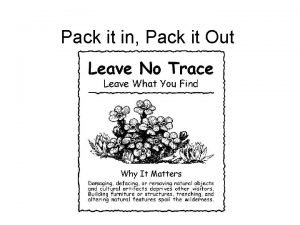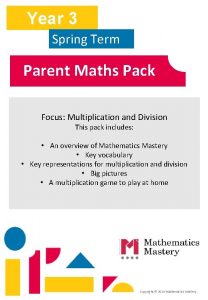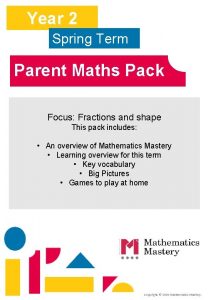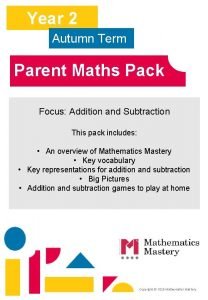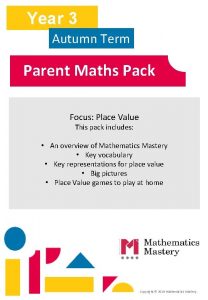Year 3 Spring Term Parent Maths Pack Focus






- Slides: 6

Year 3 Spring Term Parent Maths Pack Focus: Multiplication and Division This pack includes: • An overview of Mathematics Mastery • Key vocabulary • Key representations for multiplication and division • Big pictures • A multiplication game to play at home Copyright © 2020 Mathematics Mastery.

Mathematics Mastery What is ‘Mastery’? The ‘mastery approach’ to teaching mathematics is the underlying principle of Mathematics Mastery. Instead of learning mathematical procedures by rote, we want your child to build a deep understanding of concepts which will enable them to apply their learning in different situations. To achieve this we aim to develop pupils’ Conceptual Understanding, Mathematical Thinking and Language and Communication. (See diagram below). Representing concepts using objects, pictures, words and symbols; making connections Making conjectures, trying out specific examples, organising, comparing, looking for patterns and generalizing Conceptual understanding Mathematical problem solving Mathematical thinking Explaining, justifying and discussing using accurate mathematical language Language & communication Central to learning mathematics Success for all At school we believe all pupils can achieve success in maths. We encourage pupils to have a ‘growth mindset’ – a belief that effort leads to success and that challenges are opportunities to learn. Here a few tips to encourage your children at home with maths: ü ü ü Talk to your children about everyday maths Play games with them Value mistakes as learning opportunities Recognise that there is more than one way to work things out. Praise children for effort over outcome. Avoid saying things like “I’m useless at maths”. Copyright © 2020 Mathematics Mastery.

Spring focus: Multiplication and Division Year 3 - Spring Curriculum Map Multiplication and division Deriving multiplication and division facts Time Fractions • Multiplication and division facts for 2, 3, 4, 5, 6, 8 and 10 • Multiplicative structures: equal groups/parts, change and comparison, correspondence problems • Relationships: commutativity and inverse • Multiply and divide by 10 and 100 • Multiply a 2 -digit number by 2, 3, 4, 5 and corresponding division situations • Divide 2 -digit number by a 1 -digit number • Tell, record, write and order the time analogue and digital; • Use am and pm accurately • Measure, calculate and compare durations • Explore unit and non-unit fractions • Understand equivalent fractions • Add, subtract, compare and order fractions This term one of our key focuses in Year 3 this term is multiplication and division. Below are some of the key small steps pupils will be learning about: 1. Understand that multiplication is commutative 2. Understand the relationship between multiplication and division (exploring the inverse) 3. Recall multiplication facts for 2, 3, 4, 5, 8, 10 multiplication tables 4. Derive multiplication facts from known facts 5. Multiply a number by 10 and 100 6. Multiply a 2 -digit number by a 1 -digit number(without regrouping and with regrouping) 7. Divide a two-digit number by a 1 -digit number Key vocabulary for Year 3 – Multiplication and Division multiplication division equal groups lots of sharing array Commutative - A property of addition and multiplication. It does not matter in which order the addends or factors are added or multiplied; the result will be the same. Inverse - Opposite operations that ‘undo’ each other. Division is the inverse of Multiplication. Product - The result you get when you multiply two numbers. Ones: Tens: Hundreds: Partition - To split a number into two or more parts. E. g. we can partition 16 into 10 and 6. Regroup – To exchange 1 ten for 10 ones or unitise 10 ones for 1 ten. “ I have regrouped my 10 ones for 1 ten”. Arrays An arrangement of items (counters, objects, numbers etc) in columns and rows, used to represent multiplication and division. The array on the right represents the following equations: 3 x 6 = 18, 6 x 3 = 18, 18 ÷ 3 = 6 and 18 ÷ 6 = 3 Copyright © 2020 Mathematics Mastery.

Big Pictures What maths can you see? Discuss with your children at home using the key vocabulary from the previous page. Copyright © 2020 Mathematics Mastery.

Try this at home – workshop game Fill up the square! You will need: A pair of dice or online dice, two 10 by 10 grids. Each player has a ten by ten grid. Take it in turns to roll the pair of dice. If I roll a 3 and a 6 I need to make an array that represents 3 x 6, see example to the right. The aim of the game is to fill up the square. multiply divide array product parts whole equation equal groups Copyright © 2020 Mathematics Mastery.

Try this at home – more ideas Daily practice – multiplication and division facts Pupils in Year 3 are expected to be able to recall multiplication and division facts for 2, 3, 4, 5, 8 and 10 multiplication tables and required to know all multiplication tables up to 12 by the end of Year 4. Practising these little and often can often be the best way to remember them. Why not try putting some tables practice into your daily routine such as on the walk to school or during a car journey? Cooking is a great way to practise a range of mathematical skills whilst having fun. To practice multiplication. Why not try multiplying or dividing the ingredients of a recipe by 2, 3 or 4 to change the portion size? Array hunt An array is a set of objects arranged into rows and columns. An egg box is an example of an array. What other arrays can you find around the house? What multiplication and division problems would they represent? Helping children to find arrays in their daily lives will support their understanding of multiplicative relationships such as commutativity and the inverse. Telling the Time Although we haven’t focused on it in this workshop, another unit we cover in Spring is time. In Year 3 pupils are expected to tell the time to the nearest minute on an analogue clock. Daily practice of this at home will help to support your child. Questions to think about: Have you got an analogue clock or watch at home? If not where could they see one? Are there any outdoor clocks in your local area you could refer to? Questions to support thinking • What do you think would happen if…. • What’s the same? What’s different? • How do you know that? • • Can you see a pattern? What would come next? What else could go in this set? What couldn’t? Websites The Oxford Owl website has some helpful tips and activities for helping your child at home with times tables: https: //www. oxfordowl. co. uk/for-home/maths/times-tables-tips/ Online dice: To play the dice game included in the pack you might want to use online dice. https: //www. random. org/dice/? num=2 Copyright © 2020 Mathematics Mastery.
